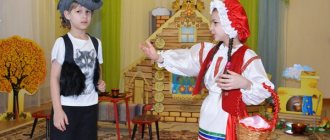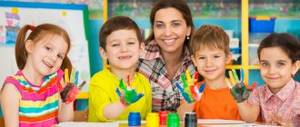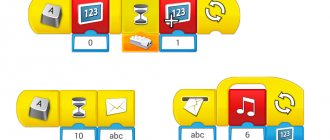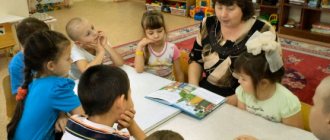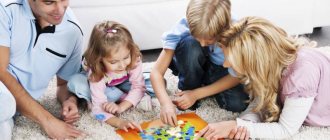Why read fairy tales in the preparatory group before bedtime?
Many parents often wonder why read books to children before bed?
Reading to children at bedtime isn't just a cute family tradition. By reading bedtime stories to the baby, parents not only give him pleasure, but also perform several important tasks:
- Strengthen and harmonize relationships with your child
In the hustle and bustle of daily activities, the attachment between an adult and a baby is constantly tested. There is not much time left to maintain close, trusting relationships. Reading books before bed becomes an indispensable ritual that creates an atmosphere of love, harmony, and joy from a common cause.
Should children in the preparatory group read fairy tales before bed?
- Calms the baby and puts him to sleep
Reading books to children before bed is the next stage of the evening parent-child relationship after the period of breastfeeding and mother's lullabies. The baby is growing up, but this does not mean that he should fall asleep without the attention, affection and tenderness of adults. The mother’s voice will forever remain the most dear and desirable sound for the child, which one wants to hear more often. Reading fairy tales together before bedtime relaxes the child and gives him pleasant emotions - the key to wonderful dreams. In addition, having a specific evening ritual also helps children fall asleep faster.
- Develop baby's intelligence
Reading books is a significant tool for a child’s early development. Reading, of course, is useful both in the morning and in the afternoon. But in the evening the human body is most relaxed, while the brain perceives information almost effortlessly. It is known that people easily reproduce in the morning what they learned or read before going to bed. This means that it will be easier for the child to understand and analyze exactly what he heard during the evening reading.
Important! You need to discuss what is happening in the book with your child, ask questions and fantasize about what will happen next! The benefits of such leisure time for a child’s intelligence are invaluable.
- Instilling in your child a love of books
In the modern world, captured by electronic technologies, you can notice the following trend: children and teenagers read less and less, but at the same time they adore computer games and can sit for hours in front of the TV, computer or tablet screen. In order to instill a love for gadgets, you don’t need a lot of work. It is more difficult to make the child fall in love with the book and continue to read with pleasure when he learns to do it on his own.
Didactic games on FEMP in the preparatory group
Note! Reading books to children at night is a simple and effective way to encourage your child to love books in the future.
- Form a healthy psyche and worldview
Fairytale therapy is a long-known educational method. “The fairy tale is a lie, but there is a hint in it, a lesson for the good fellows.” Thanks to a fairy tale, children imagine various life situations, put themselves in the place of fairy-tale characters, doing good and not so good deeds with them, fantasize, learn to sympathize, experience various emotions and states, and answer some questions for themselves. By reading books to children before bed, parents, without even thinking about fairy tale therapy, successfully use this technique.
Important! Taking into account that adults usually read good fairy tales to children, it is positive models of behavior that are fixed in children’s minds.
MAGAZINE Preschooler.RF
Organization of the educational process in preschool educational institutions to develop the perception of fiction and folklore among preschoolers 3-7 years old in the context of the implementation of the Federal State Educational StandardWorks of fiction contribute to the emotional development of preschool children, which is expressed in the desire to immediately express the feelings and emotions that arise in them while listening to fairy tales and stories in actions. Literary texts introduce children to the richness of the world of human emotions and help them understand the reasons for their occurrence and change.
Fiction has always been recognized as the main means of speech development for children: familiarity with literary works arouses interest and fosters love for the native language, its richness and beauty, enriches figurative vocabulary, and promotes the development of expressive speech in preschoolers.
Thus, familiarization with literature affects all aspects of the child’s personality. At the same time, the modern sociocultural situation complicates this process. Our society, which in the recent past was a “reading” , has turned into a “watching” one . The fading interest in reading and books had a negative impact on adults and, as a result, had an extremely negative impact on children and their personal culture. This requires innovative approaches to the selection of tasks and content of work in kindergarten in this area of teaching activity.
The conceptual position for correcting and updating the traditional approach to introducing preschoolers to fiction is to consider this problem from the perspective of literary development.
The concept of literary development is interpreted by researchers as the child’s ability to “think in verbal and artistic images” (N. D. Moldavskaya); as the realization of the experience of a child’s general mental development with an emphasis on the emotional area in the reader’s perception (V. G. Marantsman); as the embodiment of literary abilities, such as impressionability, observation, creative imagination, implying a clear and vivid representation of both directly observed impressions and images created verbally, manifested “... in the ease of forming associations between words and images” (A. G. Kovalev, A. Maslow); as a process of qualitative changes in the perception, interpretation of literary texts and the ability to reflect literary experience in different types of artistic activity (O. V. Akulova, N. D. Moldavskaya, O. N. Somkova).
The basis of literary development is the perception of a literary text. The problem of perception of a work of art is reflected in the studies of L. S. Vygotsky, L. M. Gurovich, A. V. Zaporozhets, M. R. Lvov, N. G. Morozova, O. I. Nikiforova, B. M. Teplov, O. S. Ushakova, E. A. Flerina and others.
Full perception is understood as the reader’s ability to empathize with the characters, the author of the work, to see the dynamics of emotions, to reproduce in the imagination pictures of life created by the writer, to reflect on the motives, circumstances, consequences of the characters’ actions, to evaluate the heroes of the work, to master the idea of the work.
Thus, the literary development of preschool children can be defined as a process of qualitative changes in the perception, interpretation of literary texts and the ability to reflect literary experience in different types of artistic activity.
Tasks of literary development of children of different age groups.
Tasks of working with young children:
- to cultivate in children an interest in folklore and literary texts, a desire to listen to them carefully
- enrich the “reader’s” experience (listening experience) through various small forms of folklore (rhymes, songs, jokes), simple folk and author’s tales (mainly about animals), stories and poems about children, their games, toys, everyday household activities, about animals familiar to children
- promote children’s perception and understanding of the text, help mentally imagine events and characters, identify the hero’s bright actions, try to evaluate them, establish simple connections between the sequence of events in the text
- maintain a direct emotional response to a literary work and its characters.
Objectives of working with children of middle preschool age:
- deepen children's interest in literature, cultivate a desire for constant communication with books, both together with an adult and independently
- expand the “reader’s” experience (listening experience) through different genres of folklore (jokes, riddles, chants, fables, tales about animals and magic), literary prose (fairy tale, short story) and poetry (poems, author’s riddles, funny children’s tales in verse )
- develop the ability to holistically perceive a text, which combines the ability to identify the main content, establish temporary, sequential and simple causal relationships, understand the main characteristics of the characters, the simple motives of their actions, the importance of certain means of linguistic expressiveness for conveying images of characters, particularly important events, and emotional overtones and the general mood of the work or its fragment
- support children’s desire to reflect their impressions of the works they listened to, literary characters and events in various types of artistic activities: in drawings, making attributes for theatrical games, in dramatization games, etc.
Tasks of working with children of senior preschool age:
- maintain children's interest in literature, cultivate a love for books, promote the deepening and differentiation of reading interests
- enrich the “reading” experience of children through works of more complex genres of folklore (magical and everyday fairy tales, metaphorical riddles, epics), literary prose (fairy tale, story with moral overtones) and poetry (fables, lyric poems, literary riddles with metaphor, poetic tales)
- to cultivate literary and artistic taste, the ability to understand the mood of a work, to feel the musicality, sonority and rhythm of poetic texts; beauty, imagery and expressiveness of the language of fairy tales and stories
- contribute to the development of artistic perception of the text in the unity of content, form, semantic and emotional overtones
- to promote the expression of attitudes towards literary works in various types of artistic and creative activities, self-expression in theatrical play in the process of creating a holistic image of the hero in his change and development.
Mastery of tasks is realized in joint activities organized by the teacher (developmental, problem-game and creative-game situations based on literary text, literary entertainment, theatrical games), as well as by means of organizing a subject-development environment for activating independent literary, artistic speech, visual arts. and theatrical activities based on familiar folklore and literary texts.
Literary works and their fragments are included in routine moments, in observations of animate and inanimate natural phenomena. At the same time, it is necessary to purposefully introduce children to a new text every day or organize activities based on what is already known. To enhance the emotional impact of works of art on children, it is important to combine reading a literary text with listening to music, viewing works of fine art (for example, reading poetry while children listen to music, look at reproductions of paintings, etc.).
All forms of joint activity between the teacher and children expand and deepen the reading interests of children, promote the active use of literary texts in various types of creative activities, and form the future talented reader of a great reading country.
| Next > |
Familiarization of preschool children with fiction
Such a conversation may include: a short story about the writer, a reminder of his other books that are already familiar to children. If children have been prepared by previous work to perceive a book, you can arouse their interest with the help of a riddle, a poem, or a picture. Next, you need to name the work, its genre (story, fairy tale, poem), and the name of the author.
Explanation of unfamiliar words is a mandatory technique that ensures a full perception of the work. It is necessary to explain the meanings of those words, without understanding which the main meaning of the text, the nature of the images, and the actions of the characters become unclear. The explanation options are different: substituting another word while reading prose, selecting synonyms (bast hut - wooden, upper room - room); the use of words or phrases by the teacher before reading, while introducing the children to the picture (“milk flows down the mark, and from the mark down the hoof” - when looking at the goat in the picture); asking children about the meaning of a word, etc.
Expressive reading, the interest of the teacher himself, his emotional contact with children increase the degree of impact of the literary word. While reading, children should not be distracted from perceiving the text with questions or disciplinary remarks; raising or lowering the voice or pausing is enough.
At the end of reading, while the children are impressed by what they heard, a short pause is necessary. Should we immediately move on to an analytical conversation? E. A. Flerina believed that it is most appropriate to support childhood experiences and strengthen the elements of analysis during repeated reading. A conversation started on the initiative of the teacher will be inappropriate, as it will destroy the impression of what was read. You can ask whether you liked the fairy tale and emphasize: “A good goldfish, how it helped the old man!”, or: “What a Zhikharka! Small and remote!”
At the end of the lesson, you can re-read the work (if it is short) and look at the illustrations, which deepen your understanding of the text, clarify it, and more fully reveal artistic images.
The method of using illustrations depends on the content and form of the book, and on the age of the children. The basic principle is that showing illustrations should not violate the holistic perception of the text. The main task of reading for a preschooler is to teach him to listen and hear (correctly perceive speech). A picture—an illustration placed in a children's book—helps the teacher present the child with a readable text, but it can also interfere with comprehension if shown at the wrong time.
When introducing a new book, it is advisable to first read the text to the children, and then look at the illustrations with them. It is necessary that the picture follows the word, and not vice versa - otherwise a bright picture can captivate children so much that they will only imagine it in their minds; the visual image will not merge with the word, because children will not “hear” the word, its sound shell they won't be interested. The exception is the colorful cover of the book, which arouses the natural interest and curiosity of children in this book.
